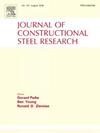Performance of partially encased composite stub columns after high-temperature exposure
IF 4
2区 工程技术
Q1 CONSTRUCTION & BUILDING TECHNOLOGY
引用次数: 0
Abstract
Partially-encased composite (PEC) structural members are now gaining increasing popularity in the construction sector. The local encasement of concrete improves the buckling resistance of the steel section, resulting in excellent bearing capacity, and the feature of convenience in connection remains. However, due to the partially exposed cross-sectional characteristics of steel, investigations into the fire-relevant performance of the PEC members are necessary and important. Thus, the post-fire mechanical behaviour of the PEC stub columns was determined as the main focus of this work. Nineteen test specimens with steel contribution ratios ranging from 0.68 to 0.76 were examined via a sequential heating-loading test procedure. The reductions of the axial bearing capacities after elevated-temperature exposures with 60 min heating (to 900 °C), 60 min heating and 30 min holding, and 60 min heating and 60 min holding are approximately 6 %, 25 % and 30 %. A finite element (FE) model was then developed based on the test results and the sensitivities of the structural parameters, including material selection, geometric characteristics and fire exposure experience, on the post-fire behaviour of the PEC stub columns were identified. The influence of the key parameters on the post-fire performance of the PEC stub columns with fire protection was also studied. Design equations were proposed based on the FE results for the PEC members with and without fire protection, in order to facilitate relevant post-fire assessment and strengthening design for the PEC structures.
求助全文
约1分钟内获得全文
求助全文
来源期刊

Journal of Constructional Steel Research
工程技术-工程:土木
CiteScore
7.90
自引率
19.50%
发文量
550
审稿时长
46 days
期刊介绍:
The Journal of Constructional Steel Research provides an international forum for the presentation and discussion of the latest developments in structural steel research and their applications. It is aimed not only at researchers but also at those likely to be most affected by research results, i.e. designers and fabricators. Original papers of a high standard dealing with all aspects of steel research including theoretical and experimental research on elements, assemblages, connection and material properties are considered for publication.
 求助内容:
求助内容: 应助结果提醒方式:
应助结果提醒方式:


